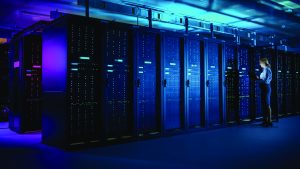This blog post is written in collaboration with PPA (PhillipsPage Associates) Consulting Engineers. Schneider Electric and PPA have worked closely on sustainable data center design and operation for several years, partnering to meet client needs in an area of rising demand.
Most hyperscale and colocation data center operators have publicly made bold pledges around their journey to Net Zero and carbon neutrality, with some even pledging to be carbon negative. Despite their good intentions, data center operators are finding that becoming more sustainable can be challenging to achieve, measure, or verify. Engineering firms can play a pivotal role in improving sustainability efforts and addressing some common challenges that hyperscale and colocation operators face.
Three sustainability challenges
1. Setting standardized sustainability metrics
There are currently no universally accepted standards or metrics associated with data center sustainability. Data center operators typically focus their efforts on reducing energy usage, increasing efficiency, and cutting carbon emissions. Also, no standard process exists for an independent auditor to conduct a sustainability inspection and provide a stamp of approval.
2. Going beyond power usage data
By limiting their focus to power usage, data center operators are missing the bigger picture regarding whether the data center itself is built sustainably, using sustainably sourced materials.
3. Capturing sustainability data
Data center operators may not be able to easily access metrics to properly assess whether the facility is operating at peak efficiency as per their original sustainable data center design once the design and build phase is completed. They need access to proper software or tools to track and report these metrics.
That’s where engineering consultants or third-party design firms can provide a considerable benefit. Consulting engineering firms can apply their expertise in all phases of a sustainable data center construction project, from the design and build phases to operations and throughout the facility’s lifecycle.
A turning point in data center sustainability metrics
The industry group Infrastructure Masons (iMasons) has prioritized the issue of using sustainable materials in data centers and is leading an industry-wide effort to address it with a climate accord that more than 160 data center operators and related companies have signed.
“Currently, there is no universal labeling system or mechanism to measure embodied carbon over the life of the materials used to build data center facilities or the products that fill them,” says the iMasons group.
Companies in the climate accord have agreed to create standards to report carbon in data center materials and products, carbon intensity in power consumption, and developed a maturity model to report participant progress. In addition, organizations can access this Schneider Electric white paper, A guide to environmental sustainability metrics for data centers, which includes 23 key metrics for data center operators in various stages of their sustainability journey.
Engineering consultants can partner with data center operators to align with these standards, help reduce Greenhouse Gas (GHG) emissions, and consult on how to improve sustainability when it comes to Scope 1 and 2 emissions. Check out this blog post for a quick refresher on the differences between the Scopes.
In addition to designing and constructing sustainable data centers, engineering consultants can also play a significant role in maintaining sustainable operations. Jon Phillips, managing director at PPA, says that consulting firms can serve as trusted partners in the ‘operate’ and ‘maintain’ phase of data center construction projects. Once the data center is operational, consulting firms can verify that the facility is running to its sustainable design specification and that the products installed are operating as efficiently as their label prescribes. Then, they can make recommendations to optimize.
The sustainability ecosystem
Hyperscale and colocation operators don’t have to go it alone on their sustainability journey. Instead, they can leverage a sustainability ecosystem to help them target sustainability metrics and achieve specific metric goals.
The traditional consulting engineering firm’s role is evolving to that of a sustainability accountability partner. These firms can even serve an additional role as independent auditors or inspectors who can evaluate a data center and validate whether the facility is meeting its sustainability design goals.
Being a specialist data center consulting firm, PPA is well-placed to work with clients to ensure their target energy efficiencies can be realized in live projects long after the design has been completed. By combining digital twin software such as eTap along with their specialist engineering expertise, they optimize the constructed facilities so actual energy efficiency goals can be met.
At Schneider Electric, we are also doing our part to help customers meet sustainability goals, particularly by sourcing sustainable materials that follow best practices for recycling, durability, upgrades, and repairs. Today, 78% of Schneider Electric products are covered by Product Environmental Profiles, which provide embodied carbon calculations. In addition, we are working toward 100% coverage of cloud and service provider offers in 2023. Many of these efforts fall into addressing Scope 3 emissions. For Scope 3 emissions reporting, don’t miss this recently released White Paper #53: Recommended Inventory for Data Center Scope 3 GHG Emissions Reporting.


